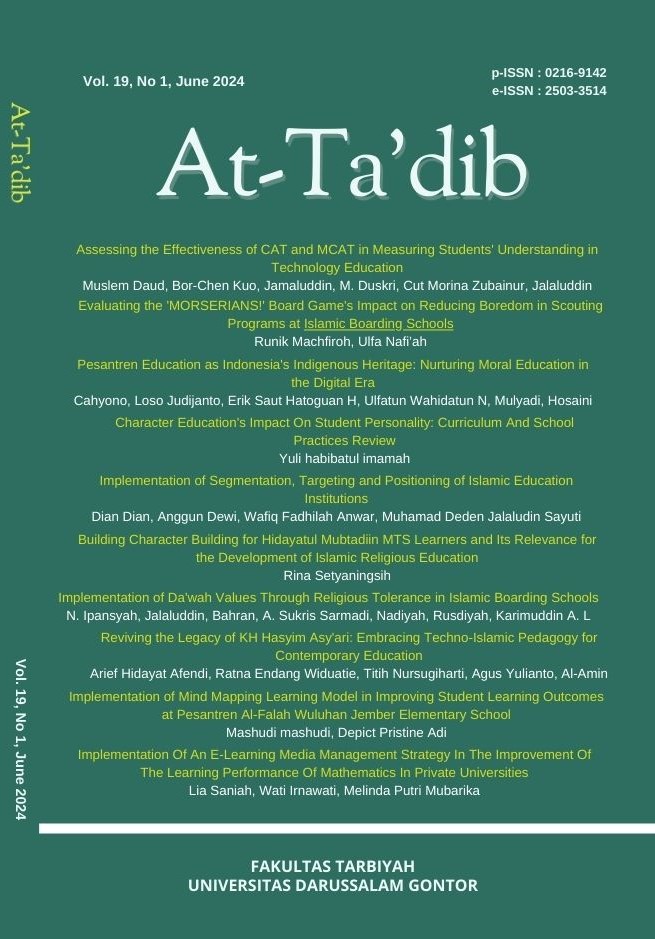Implementation of Mind Mapping Learning Model in Improving Student Learning Outcomes at Pesantren Al- Falah Wuluhan Jember Elementary School
DOI:
https://doi.org/10.21111/attadib.v19i1.10066Keywords:
Mind mapping, Learning Outcome, Islamic Religious Education, Classroom Action ResearchAbstract
The problem in this study is that learning is dominated by the lecture method by teachers. The purpose of this research is to analyze the use of the mind mapping model in improving the learning outcomes of Islamic Religious Education in grade V students of SD Pesantren Al-Falah Wuluhan Jember. The use of the mind mapping model is very effective to come up with ideas and notes that students make to form a pattern of thinking with the topic and sub-topic of discussion and its branches. The mind mapping model prepares, first to determine learning objectives, second to compile learning tools using the mind mapping learning model, third to prepare cartons and color tools to make mind mapping, and fourth to make evaluation tools. After that, learning is by what you want to achieve or RPP. The research used is Class Action Research where the implementation of research is carried out in 2 cycles of Action treatment. Each cycle is carried out in the presence of planning and execution. The object of study was 22 students consisting of 10 men and 12 women. The results of the study stated that the treatment cycle began with a procyclical which obtained an average of 42.27 from 22 students. This condition was continued on Action Cycles 1 and 2 with an average gain of 64.55 and 85.77, respectively. From the three cyclical actions, the completeness of learning outcomes in cycle 1 was 36.36%, and in cycle 2 it was 77.27%. From the results of the study, it can be concluded that the use of the mind mapping model can improve student learning outcomes in Islamic Religious Education subjects with the subject matter Lesson 2 Knowing Allah and His Book.References
Agung, Dewa Agung Gede. “Pembelajaran Sejarah Di Era Revolusi Industri 4.0.†Jurnal Pendidikan Sejarah Indonesia 4, no. 1 (June 16, 2021): 1–8. https://doi.org/10.17977/um0330v4i1p1-8.
Buzan, Tony. The Ultimate Book of Mind Maps. HarperCollins Publishers, 2006.
Carr, Wilfred, and Stephen Kemmis. Becoming Critical: Education Knowledge and Action Research. 1st Edition. London: Routledge, 1986. https://doi.org/10.4324/9780203496626.
Elliott, John. Action Research for Educational Change. Developing Teacher and Teaching Series. USA: Great Britanian, 1991.
Erdem, Aliye. “Mind Maps as a Lifelong Learning Tool.†Universal Journal of Educational Research 5, no. 12A (December 2017): 1–7. https://doi.org/10.13189/ujer.2017.051301.
Hartati, Risma. “Metode Pengajaran IPS Yang Efektif Di SD.†Bina Gogik 5, no. 1 (2018): 43–53.
Hidayat, Muhammad Yusuf, A. Nenyhindarwaty A, and Fitriani Nur. “Analisis Penentuan Standar Nilai Kriteria Ketuntasan Minimal (KKM) Mata Pelajaran Fisika Kelas XI SMAN 17 Makassar.†JPF (Jurnal Pendidikan Fisika) Universitas Islam Negeri Alauddin Makassar 8, no. 1 (March 16, 2020): 74–81. https://doi.org/10.24252/jpf.v8i1.7837.
Husni, Muhamad. “Memahami Konsep Pemikiran Mind Map Tony Buzan (1970) Dalam Realitas Kehidupan Belajar Anak.†Al-Ibrah 3, no. 1 (2018): 110–26.
Kirom, Askhabul. “Peran Guru Dan Peserta Didik Dalam Proses Pembelajaran Berbasis Multikultural.†Jurnal Al-Murabbi 3, no. 1 (2017): 69–80. https://jurnal.yudharta.ac.id/v2/index.php/pai/article/view/893.
Musya’Adah, Umi. “Peran Penting Pendidikan Agama Islam Di Sekolah Dasar.†AULADA: Jurnal Pendidikan dan Perkembangan Anak 1, no. 2 (2018): 9–27. http://e-journal.ikhac.ac.id/index.php/aulada.
Nanti, Sri. “Guru Masa Depan, Harus Keluar Dari Zona Nyaman Dan Tingkatkan Kompetensi,†Agustus 2022. https://www.kompasiana.com/nanti2780/6304668f5c392b48083b5232/guru-masa-depan-harus-keluar-dari-zona-nyaman-dan-tingkatkan-kompetensi?page=all#section1.
Nasution, Mardiah Kalsum. “Penggunaan Metode Pembelajaran Dalam Peningkatan Hasil Belajar Siswa.†STUDIA DIDAKTIKA: Jurnal Ilmiah Bidang Pendidikan 11, no. 1 (2017).
Prasad, G. N. R. “Evaluating Student Performance Based on Bloom’s Taxonomy Levels.†In Journal of Physics: Conference Series, 1797:012063. India: IOP Publishing, 2021. https://doi.org/10.1088/1742-6596/1797/1/012063.
Said, Alamsyah, and Andi Budimanjaya. Strategi Mengajar Multiple Intelligences : Mengajar Sesuai Kerja Otak dan Gaya Belajar Siswa. Jakarta: Prenada Media Group, 2015.
Sekretaris Negara Republik Indonesia. “Undang-Undang Republik Indonesia Nomor 20 Tahun 2003 Tentang Sistem Pendidikan Nasional.†Jakarta, 2003.
Sopian, Ahmad. “Tugas, Peran, Dan Fungsi Guru Dalam Pendidikan.†Raudhah Proud To Be Professionals : Jurnal Tarbiyah Islamiyah 1, no. 1 (2016): 88–97. https://doi.org/10.48094/raudhah.v1i1.10.
Sufiati, Vivi, and Sofia Nur Afifah. “Peran perencanaan pembelajaran untuk performance mengajar guru pendidikan anak usia dini.†Jurnal Pendidikan Anak 8, no. 1 (2019): 48–53. https://doi.org/10.21831/jpa.v8i1.26609.
Susilowati, Dwi. “Penelitian Tindakan Kelas (PTK) Solusi Alternatif Problematika Pembelajaran.†JURNAL ILMIAH EDUNOMIKA 2, no. 01 (February 19, 2018). https://doi.org/10.29040/jie.v2i01.175.
Downloads
Submitted
Accepted
Published
How to Cite
Issue
Section
License
Copyright (c) 2024 Mashudi Mashudi, Depict Pristine Adi

This work is licensed under a Creative Commons Attribution-ShareAlike 4.0 International License.
Copyright Notice
Authors who publish with this journal agree to the following terms:
- Authors retain copyright and grant the journal right of first publication with the work simultaneously licensed under a Creative Commons Attribution License that allows others to share the work with an acknowledgment of the work's authorship and initial publication in this journal. Creative Commons Attribution-ShareAlike 4.0 International License.
- Authors are able to enter into separate, additional contractual arrangements for the non-exclusive distribution of the journal's published version of the work (e.g., post it to an institutional repository or publish it in a book), with an acknowledgment of its initial publication in this journal.
- Authors are permitted and encouraged to post their work online (e.g., in institutional repositories or on their website) prior to and during the submission process, as it can lead to productive exchanges, as well as earlier and greater citation of published work.
- The author warrants that the article is original, written by stated author(s), has not been published before, contains no unlawful statements, does not infringe the rights of others, is subject to copyright that is vested exclusively in the author and free of any third party rights, and that any necessary written permissions to quote from other sources have been obtained by the author(s).

AT-TA'DIB: Journal of Pesantren Education Published by Faculty of Tarbiyah, University of Darussalam Gontor, Indonesia is licensed under a Creative Commons Attribution-ShareAlike 4.0 International License.
Based on a work at https://ejournal.unida.gontor.ac.id/index.php/tadib/index








